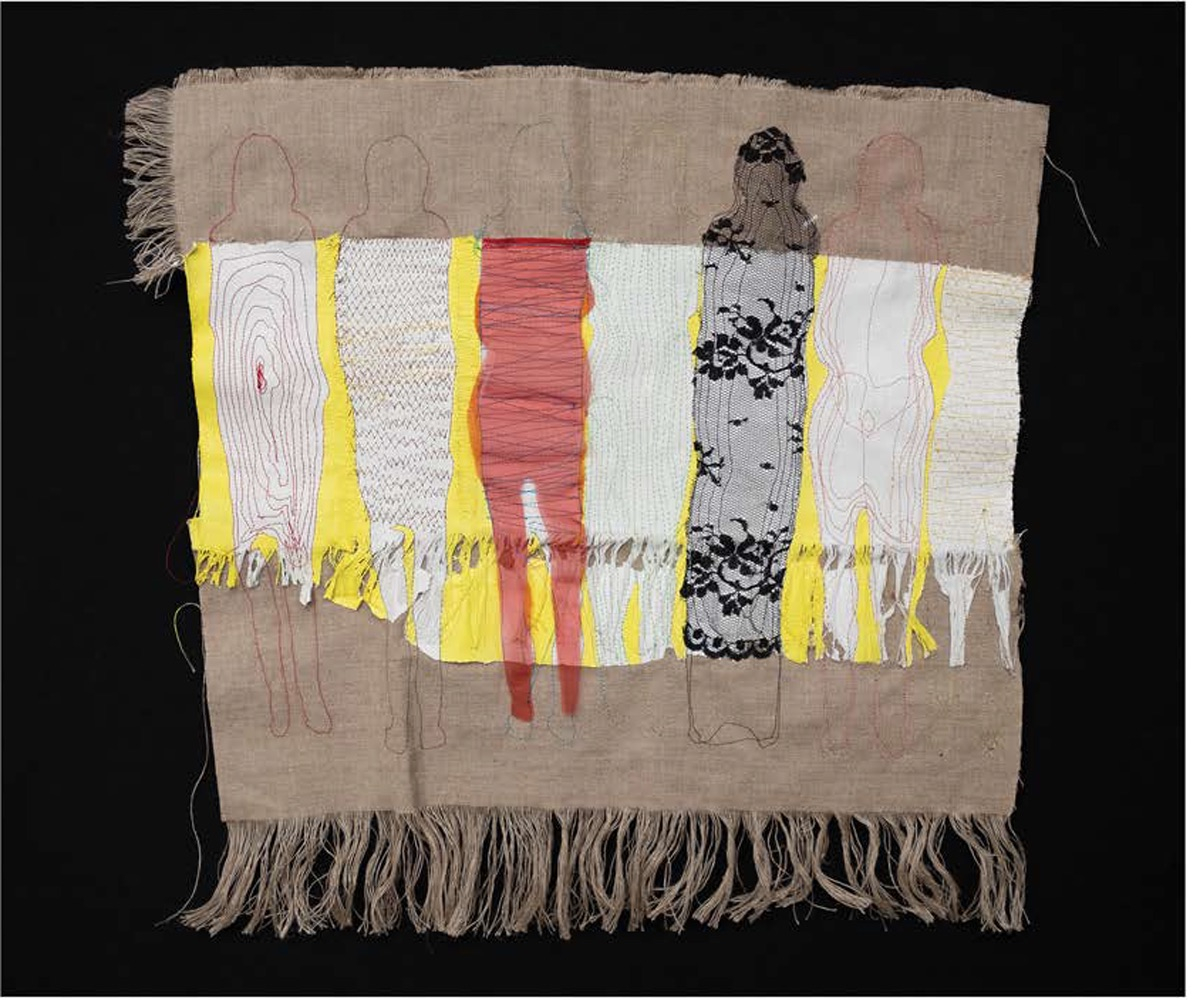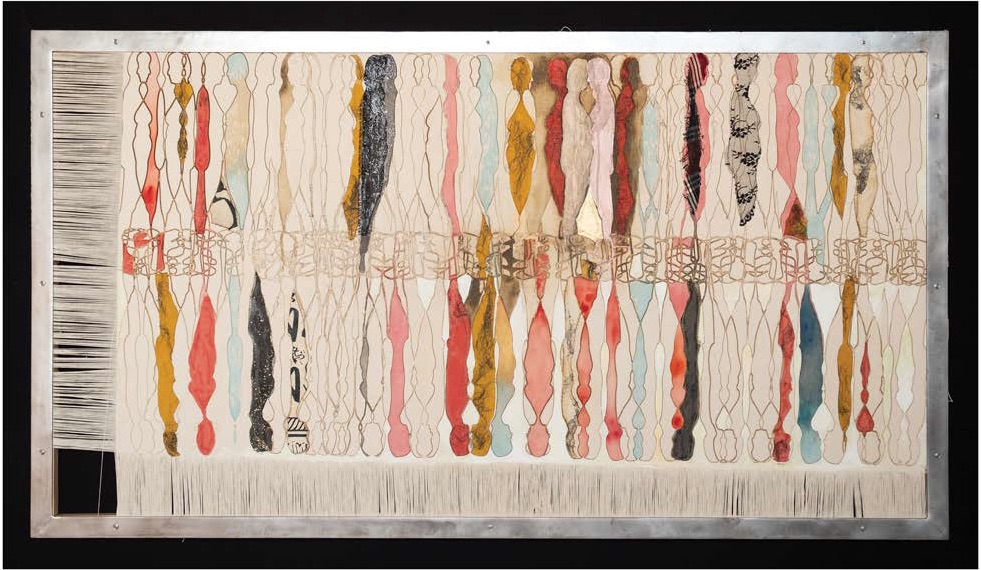
Pink Dreams in a Land with No Name
Elga Wimmer PCC, NYC
9/11 – 9/24, 2019
On view at Elga Wimmer PCC, the exhibition "Pink Dreams in a Land with No Name," curated by Roya Khadjavi, presents nineteen visual art works comprised of twelve mixed media pieces and nine laser cut canvas collages, created by Iranian born artists Sara Madandar and Shahram Karimi, who both currently reside in the U.S. The show explores the strategies the artists have conjured in order to come to terms with their experiences as immigrants living a demanding cross-cultural existence, intensified by the anti-immigration political climate in the U.S. and the social constraints inherent in Iran. Through the creative process of confronting, sorting, and clarifying painful memories and impulses, elucidating notions of place, nation, gender and self, the artists forge the essence of their inner identities and current personas, in works that speak to the feelings and difficulties of displaced people worldwide.
Sara Madandar employs metaphoric gestures of release and reclamation, obliterating and reconfiguring the canvas on which she eventually forges a renewed symbolic sense of national place, as her body itself becomes her newly claimed nation and home. In efforts to regain her unique persona in the context of life in an unfamiliar new culture, she reexamines her body, the center of memories and experiences, by stitching her own contours onto cloth formats in a variety of compositions. The repeated outlines, contrasted with full bodily forms, are split and layered, suggesting discomfort and disorientation as she moves toward integration within herself.
By enduring moves from Iran to Texas, finally settling in New Orleans, Madandar's sense of national identity became eroded in the process of adjusting to new cultures. She began to question the meaning, borders and symbols that relate to place, eventually arriving at a renewed sense of home centered in her own body. Madandar began to picture her own body as her homeland, as a free land without nationality or borders which she could redeem as the center of herself. She has reconciled the pain and loss that result from immigration through the creative process. Her art speaks to all people, especially women, who experience loss of their identities by the act of migration.
In her canvas and cloth-based collages Madandar employs a laser cutter in a calibrated process, in which she carefully cuts the canvas without setting it on fire, or breaking it. In the work entitled "Persian Fall" (acrylic on canvas, 34 x 66," 2019), the artist unravels thread from the edges of a canvas stretched on wooden bars, destroying portions of the surface to expose the stretchers that support it. She retains part of the intact canvas, allowing the ends to remain unraveled. The piece suggests the deconstruction of remembrances of the past as it recedes from one’s consciousness. With this action she generates a basis for rebuilding a life that has fallen into tatters from the stresses engendered by manifold relocations. The bars function as a metaphoric structure that supports her explorations. In the masterful piece entitled "Through Roots" (acrylic, stitchery, collage and laser on canvas, 36 x 65," 2019), Madandar multiplies her body form in overlapping outlines, turned right-side up and upside down, eradicating its contours to make space for the symbolic voices of those engaged in simultaneous processes of self-reinvention.

Madandar has recently turned from her primary medium of painting to a sewing machine, using thread and cloth on canvas in order to challenge herself with an unfamiliar speed and freedom of movement. At times she stitches repeated layered silhouettes of her bodily form on cloth embossed with flowers or traditional Iranian texts, to retain traces from her background. The artist incorporates outlines of her nude body while pregnant, to bring those physical adjustments into a coherent whole. Her signature silhouettes may express loss, while the solid cloth forms indicate stages of growth in a new vision of herself.
"Window #1," built as a traditional Iranian window, with green, yellow and red panes that each displays a delicately painted nude woman, allows the viewer to control the LED light source. The piece lends insight into the tension inherent in a dual culture. At home in Iran, Madandar is free to be nude, to reveal herself to herself as she is by nature. This freedom, as fulfilling as it is, may induce a sense of isolation. The strain that arises from conflicts between a hidden but free private life and a socially exposed but impersonal public persona, creates an agonizing divide. The delicacy of Madandar's two-toned female form symbolizes the tenuous hold she has in Iran on the luxury of privacy that makes existence worth living. Madandar focuses on her personal issues to find resolution which has universal parallels. She speaks through her art to new immigrants and all disposed and displaced persons, as she integrates her life in America with memories of Iran within the realm of her own body, herself.
Global artist and film maker Shahram Karimi instills his paintings with touching imagery culled from personal experiences of village life, such as roses and poppies that decorate clothing of women in his native homeland of Shiraz. In a courageous effort to retain memories that stamped his early persona, he moves forward in his present cross-cultural existence as an artist who resides in both Germany and the U.S. Karimi's paintings empower his identity by allowing him to bring his feelings into images that cement them in his consciousness. In this positive way he reclaims his past by inventing his own iconography, in heartfelt narratives which accentuate recollections of his cherished history. He has been exposed to the Western genres of abstraction, minimalism and conceptual art, yet in an authentically global vision, he depicts recognizable figurative human forms engaged in enterprises and rituals, such as weddings and funerals, that relate universally to the ongoing concerns of people everywhere. In this way he recognizes and respects the spectrum of his life as a whole, with the realization that there is no way back to the past from a frenetic and fast-paced life in the West.
Despite or because of the fact that Karimi is an autodidact, his technique is skillful, confident and sensitive. He paints freely from his heart without gimmicks or formulas, in works which occupy the picture format frontally, without perspective or traditional spatial pictorial depth, inspired by the mysterious visual poetry of Persian miniature paintings. Karimi is a humanist whose broad view of life encompasses activities and celebrations, births, travels and rituals. His reality is immersed in a broad sense of the human predicament, its joy, its pathos and its limitations and longevity. Karimi's exuberance has enabled him to create shimmering narrative tableaux inspired by his formative years in Iran, highlighted by emotionally charged pink tones that stress the present, contrasted with cool blue hues which denote reminiscences.

In many works such as "Angel" and "Untitled" Karimi employs lines to delineate forms and features, while in other works such as "Sisters," two broad faceless figures merge to become one entity which commands the entire space. The artist is especially engaged by female forms in repose, whose enigmatic shapes are reluctant to reveal their specific content. In "Angel" Karimi stresses the coexistence in Iran of the Roman Catholic religion with Islam, by depicting the Virgin Mary holding the baby Jesus, surrounded by angels. Karimi expresses his humanistic perceptions in the video-painting entitled "Red Poppy," inhabited by poetically painted, frontally posed individuals set next to the national Iranian flower which, enhanced by video, sways with life.
In many of his deep, serious works the artist employs glazing techniques by applying thin veils of color over underpaintings of figures and flowers. The technique enables him to subtly project the past into the present, creating a mood synonymous with memory and instilling a sense of time passing. In the picture entitled "Looks" (image above), the artist creates depth that hints at recollections of incidences of the past, by painting characters strewn over flowered brocade fabric, in visions of faces that appear to materialize as witnesses. This augmented dimension aids the bright pink flowers on the surface to visually and symbolically bridge the artist's past with his present life.
Karimi appears to be grappling with the jarring realities of his current existence, but seems cognizant that returning would be unthinkable. He imprints his works with bits of Iranian poetry (a source of national pride), concealed in hidden corners, that enhance his remembrance of historical events. Karimi struggles with the multiplicity of the life he faces in Germany and the U.S. by channeling cherished growth experiences into narrative paintings that forge a personal iconography. He expresses a unique, global vocabulary which employs, and transcends, the Western genres of abstraction, minimalism and conceptual art.
Karimi and Madandar both resiliently face the dilemma of the cross-cultural displaced individual by reconciling the grief that arises from relocating, especially into a new land hostile to immigrants. Madandar envisions her body as a new homeland, and Karimi narrates images of individuals engaged in historic rituals that rekindle and enhance his present engagement with his past life in Iran.
